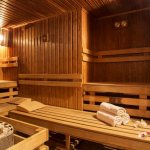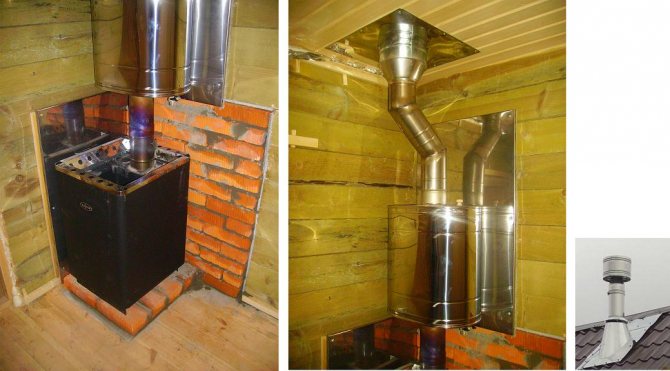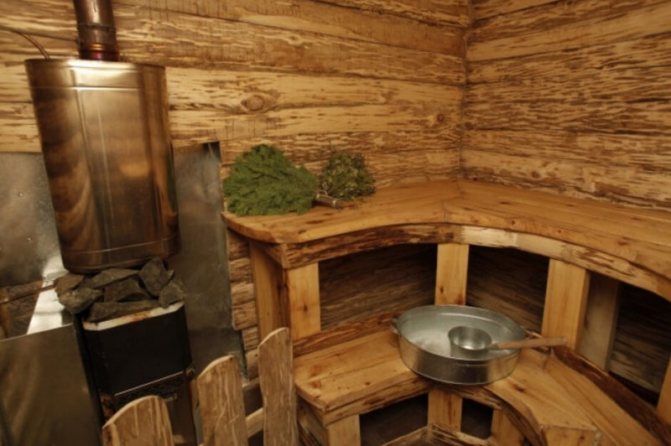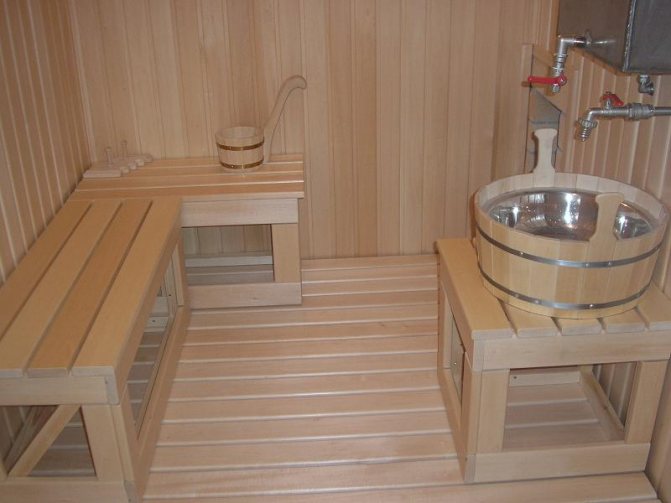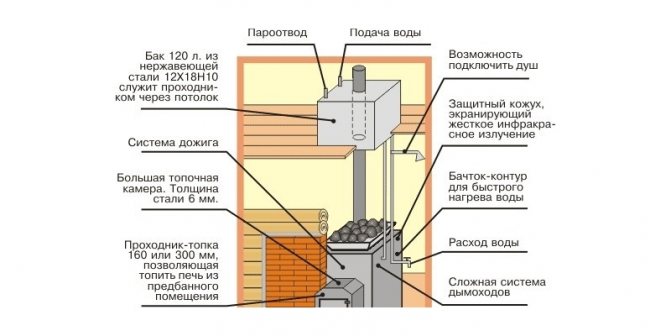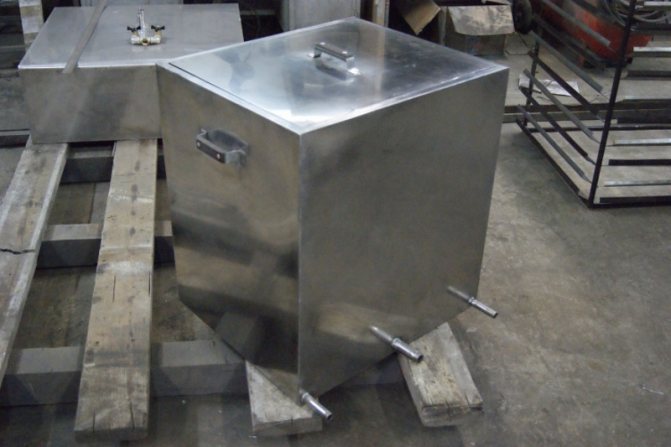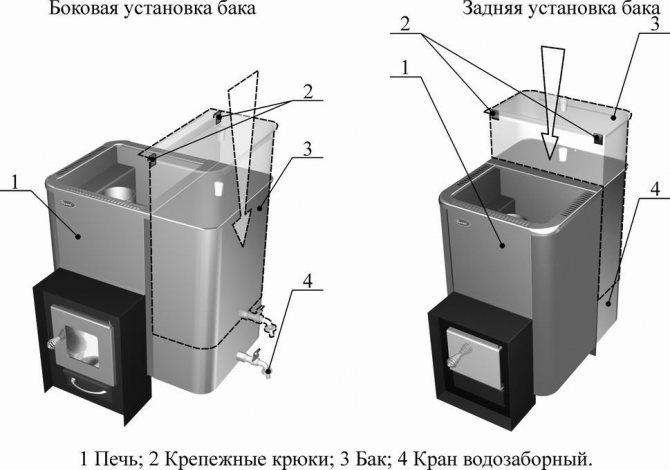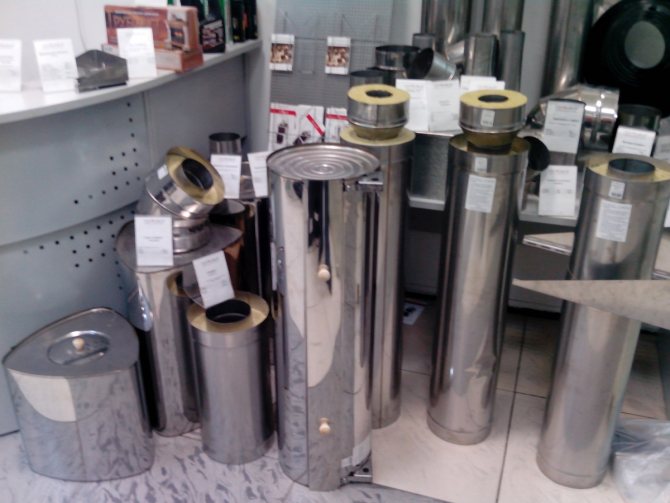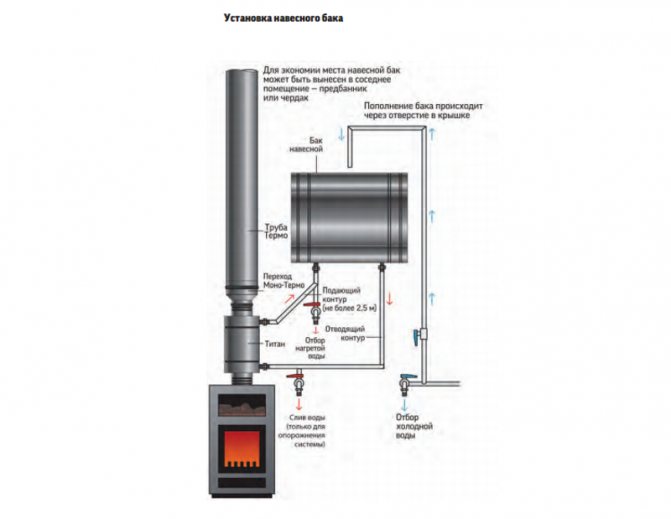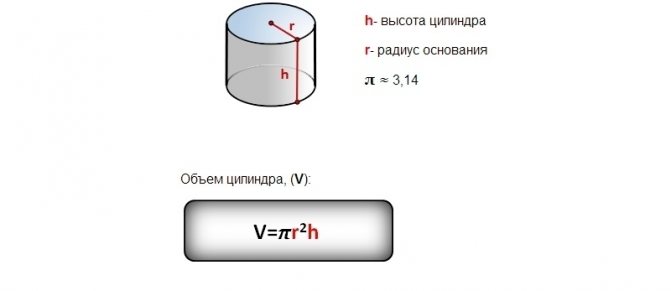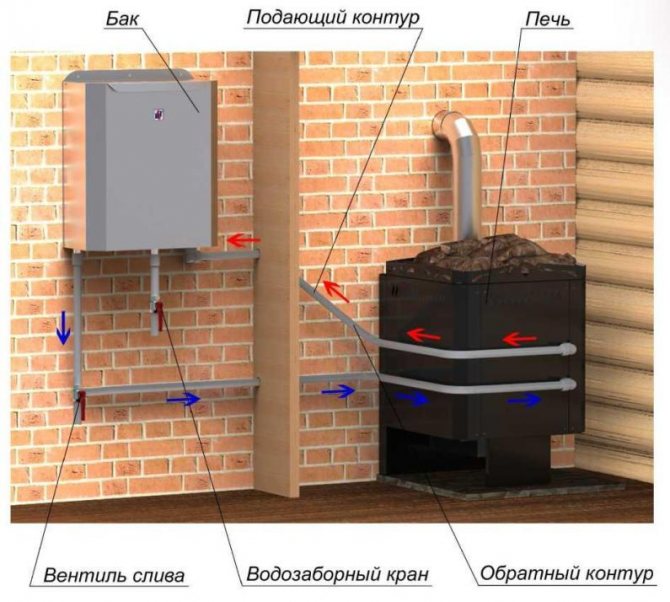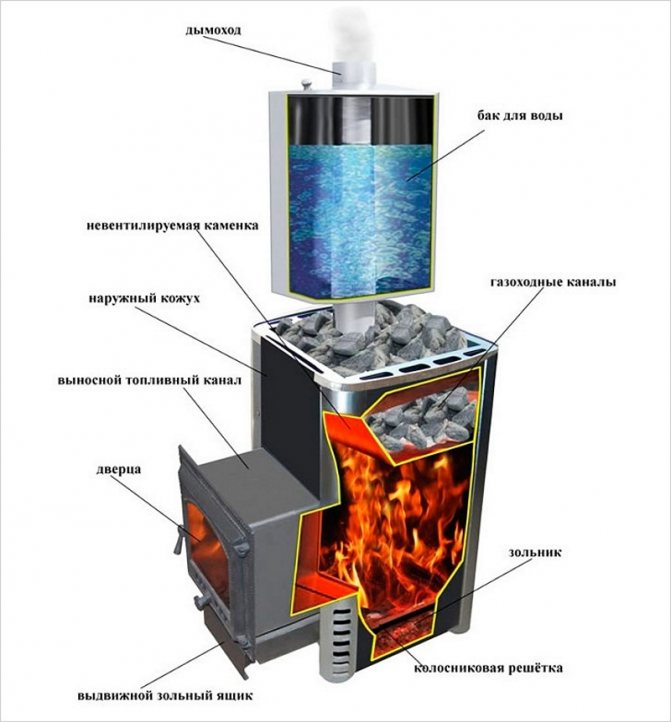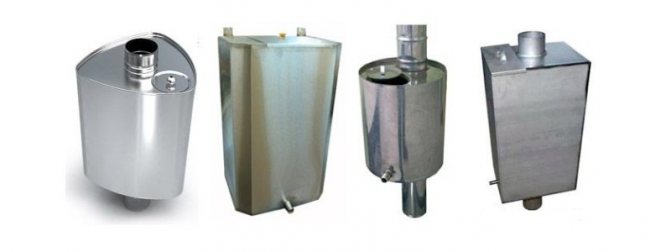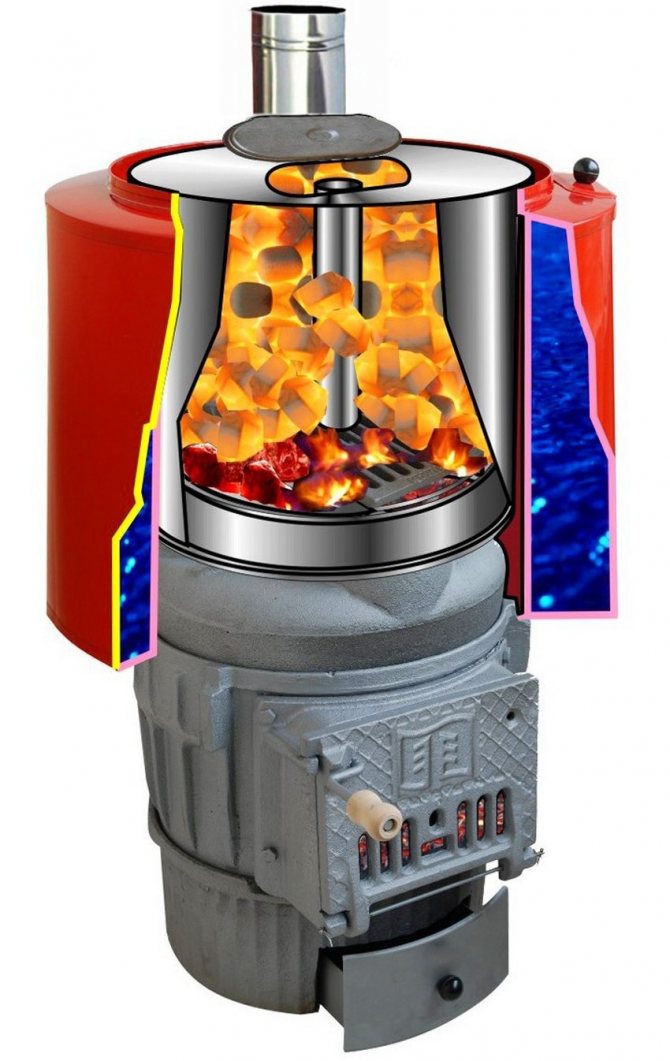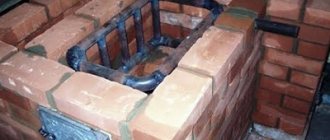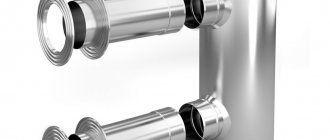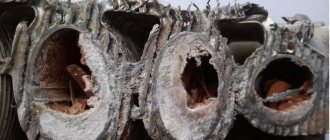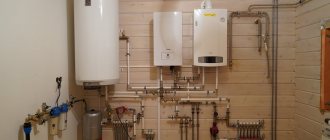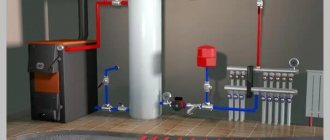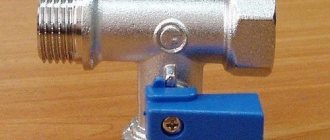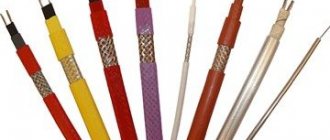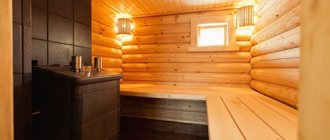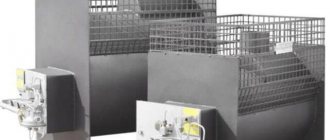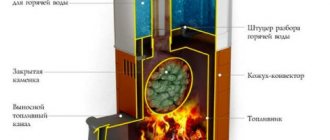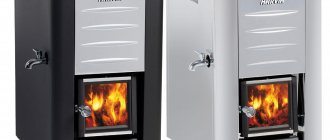Features of the device of stoves for a bath with a water tank
- A stove is a part of a stove that stores heat from heating stones. They are warmed up by burning wood from the firebox.
- The firebox is a part of the furnace in which fuel is burned and heat energy is released. It contains a grate, which is placed in different positions depending on the type of fuel. For a firebox, it is placed at the level of the sealed door.
- The lattice is most often made of cast iron, as it is a reliable, durable alloy.
- Ash pan - the area under the firebox. It accumulates ash, which is then cleaned out by hand.
- Walk-through tunnel with a door - mounted for the ability to heat the bath in the dressing room, in an adjacent room.
- A heat exchanger is a device that allows heat to be transferred to water from the firebox.
- The chimney is a pipe that comes out of the firebox and removes the smoke from the combustion to the street.
Stoves are made of stainless steel, ferrous metals, bricks.
- compactness
- reliability
- ease of use
- profitability.
- Heat generator and steam generator power regulating device
- Adjustable heat transfer power, which should be enough to heat the steam room. It so happens that it is not enough to heat a certain type of bath
- Convection system that allows you to regulate temperature differences and heat the bath faster
- The coating should be as strong as possible
Choose a stove with a water tank carefully and slowly. A quality oven should have the following characteristics:
- Powerful heat transfer: the volume of heat generated from the stove should be enough to heat water and air in the bath, as well as maintain a stable temperature.
- Control devices: air temperature control, water drain taps, convection equipment.
- Durable, heat-resistant and resistant to constant temperature changes.
It should be remembered that the bathhouse is a place of increased risk, therefore, any wood-fired stove with a water tank must meet the basic fire safety requirements:
- The stove must have a solid concrete foundation.
- The oven cover should be as flat as possible, without bumps and dents.
- The floor near the stove must be made of non-combustible material in order to exclude the possibility of ignition from falling out coals.
- The wall against which the furnace and tank are adjacent must be made of refractory materials.
- The side walls of the oven should be as far away from flammable objects as possible.
Please note: many furnace models are equipped with a tank at the production stage. However, there are also containers that have a universal design and can be installed on different types of ovens.
When deciding on the choice of a particular tank, one should take into account the peculiarities of their operation, technical characteristics and the specifics of installation. Each type of this tank has its own strengths and weaknesses, which the owner of the bath should know about in advance.
| Samovar | Remote | Built in | |
| Benefits |
|
|
|
| disadvantages |
|
|
|
How to justify the choice
If a stainless steel bathtub is intended solely for storing a supply of cold water, then it is irrational to use stainless steel and here's why. The stainless steel is expensive. In addition to expensive raw materials, it is also difficult to process, primarily due to its increased mechanical strength and toughness. In addition, welding of stainless steel involves the use of special technologies, for example, the formation of a protective gas, argon, carbon dioxide, nitrogen, helium and their mixtures above the welding bath. What can be the alternative?
- Containers made of ferrous metal, provided that they are properly protected from the effects of moisture by applying a protective coating: waterproof primer, paint, enamel layer and others.
- Plastic tanks, which are much more practical, lighter, more mobile and more durable than metal ones, as they are not subject to corrosion.
It should be borne in mind that a polymer container can compete with a metal one if it:
- Made from primary, not processed raw materials;
- Has reinforcement of the body with polyamide thread, which increases the tensile strength of the wall by an order of magnitude;
- Will not be exposed to direct sunlight and intense heat from nearby heaters.
Operating principle
Such stoves work according to the following scheme: they put and kindle firewood, fuel, emitting heat, into the firebox. Since hot air is much lighter than cold air, it rises through the stove and heats the stones. They get very hot and keep the required temperature in the room for a certain time.
When working with some devices, you often have to throw up firewood, as they quickly burn out and a comfortable temperature is kept for a short time. Firewood is usually lit from below.
There are ovens with a long burning time. Such devices work without throwing firewood for 6-20 hours, which frees you from long control. The combustion process in such furnaces occurs in the opposite direction - from top to bottom.
We offer you to familiarize yourself with the Boiler for water heating: how to make a boiler for a wood-burning system with your own hands, advice from experienced craftsmen
It is best to use birch and alder logs, peat briquettes or coal. Use only dry wood to heat the room to speed up the heating process. It is not recommended to use coniferous wood, because it produces a lot of soot that pollutes the chimney.
Furnace types by material
Sauna stoves with a water tank are made of two materials:
- Metal devices are made mainly of cast iron and steel. There are many models on the market. In shape, they are square, rectangular and can even be cylindrical.
PROS:
- low price
- easy installation
- no foundation needed
- fast heating of the steam room
MINUSES:
- poor resistance to temperature changes
- cool down quickly
PROS:
- they have a more aesthetic appearance
- keep the heat in the bath longer
- last longer
MINUSES:
- need a foundation
- more labor costs when setting up
Advantages and disadvantages
When heating a bath, you do not need to spend resources on heating water
A tank of sufficient capacity will provide residents with heated water for hygiene and household needs. The liquid in the tank eliminates the dry air problem. Compared to hot water devices running on gas or electricity, the advantage of using a tank is that there is no additional consumption of resources. Connecting the tank to the stove will also help out in the event of a temporary shutdown of the supply of trunk resources.
The cons of tanks depend on the material and type of construction. In steel tanks, water cools quickly, cast iron ones are heavy. Mounting the tank on a pipe requires special skills. The heating rate is influenced by the wall thickness of the product.
Water tanks on Teplodar ovens
When choosing a stove for a bath, pay attention to its equipment. Some models are already equipped with a water tank. If the container needs to be selected separately, please note that a water tank can be installed on all models of sauna stoves produced.
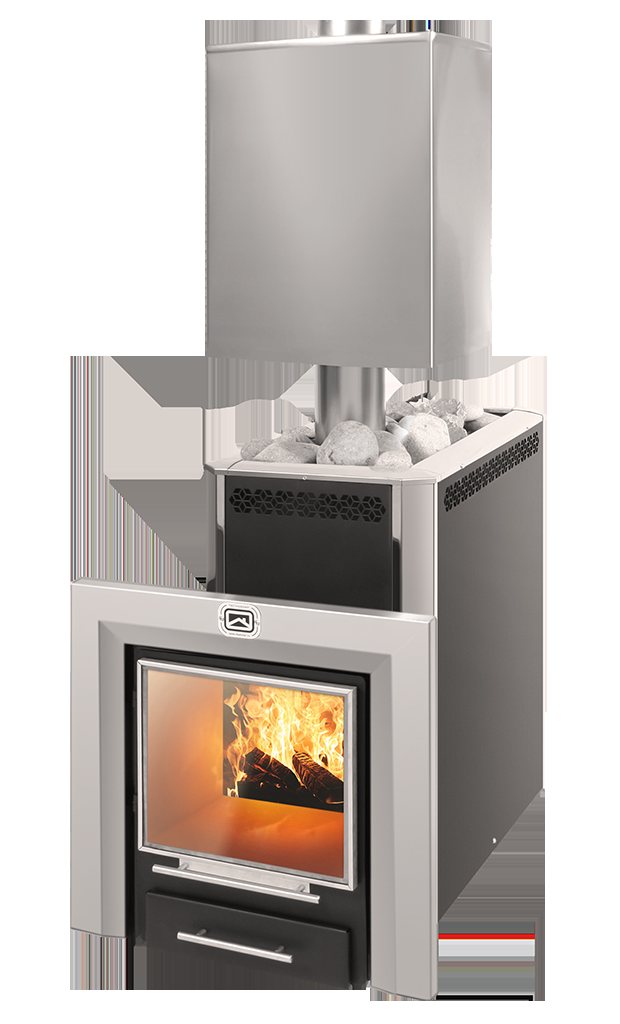
The samovar-type water tank can be installed on any stove from.
It can be installed on any oven from. Installation of the tank in difficult or cramped conditions, for example, when installing it on a stove with the chimney axis shifted to the front wall, will not pose any difficulties. In this case, we recommend choosing a water tank with a capacity of 70 liters from the wide range of our online store.
An economical option is to place a samovar-type water tank over an open stove (for example, in the Novaya Rus, Kaskad, Taman ovens). So the water will heat up twice as fast, since two heat sources will be involved at once.
Remote tank
A portable water tank can be installed on the Teplodar furnace model with a heat exchanger.
Before installing the remote tank, pay attention to the presence of a heat exchanger on the stove. It may not be in the finished product, but then it should be possible to install it. If the abbreviation of the name of the production furnace contains the letter "P", then the heat exchanger is already built-in (models "Siberia" and "Siberia-Panorama"). If not, you will need to install a universal register that is suitable for all models of stoves (for example, "Rus-Panorama" and "Sahara").
Built-in tank
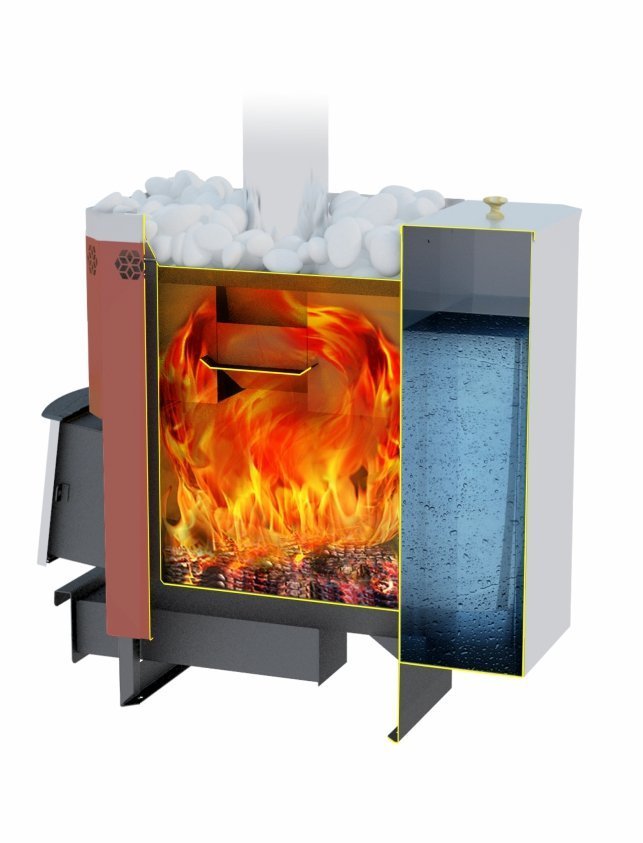

The built-in water tank is the least hassle for the owner of the Teplodar oven - it is enough to install a fully equipped oven of the required model.
This water tank is the least hassle for its owner during installation - just install a fully equipped stove. The container can be in contact with the top or side wall of the furnace (depending on the design of the furnace). In our online store, there are wood-fired sauna stoves with a tank on the side wall, such as "Sahara 10 LB" and "Sahara 10 LBU", as well as a modification of the "Taman 10 TB" stove.
Types of sauna stoves by the location of water tanks
- remote tanks located separately from the oven
- built-in containers that are located in the body of the structure
- hanging tanks
- attached
- chimney
Remote tanks
This type of tank location is one of the best. It enables the stove to warm up the water and at the same time keep the adjacent room warm. And it also prevents the spread of moisture in the steam room while it is not yet really warmed up.
Most often, these tanks are made of stainless steel and placed in a nearby room. In order for the water to heat up from the stove, a register is installed that connects them through pipes or hoses.
It is better to use pipes that can withstand high temperatures to connect the water tank and the heat exchanger. It is best to install stainless steel or copper pipes 50 cm from the stove. Reinforced-plastic pipes for hot water must be connected to them through fittings.
How to use
Pour water into the system while it is not hot. If it is poured in while the device is warmed up, the register can burst from sudden changes in temperature.
- the lower edge of the container should be located above the register by half a meter or more
- the total length of pipes or hoses must be no more than 3 meters
- the diameter of the pipes must be at least 2.5 cm
- sagging is excluded
- the slope should be 2-5 degrees
PROS:
- the ability to make a shower, a Finnish sauna, connect a battery for heating in winter changing rooms or showers
MINUSES:
- complexity of installation and connection
- rather big price for all the necessary parts of the system: heat exchanger, pipes, taps, installation costs from the masters
Built-in tanks
This is the basic type of tanks for sauna stoves, they are placed above the firebox or on one of its sides. The shapes of containers are different, but the most common is rectangular.
They are made of stainless steel, the wall thickness is in the range of 0.8-1.5 mm. Water is poured into them through a special hole, it is drained through ball valves. Nevertheless, such tanks are considered inconvenient, since they cannot be left empty, and constant boiling water creates excess, heavy and untimely humidity in the bath.
This forces you to frequently drain hot water and pour cold water. In addition, it is inconvenient to control the liquid level in the tank.
Hanging tanks
Hinged tanks are airtight containers with a lid and taps equipped for draining water. Such a tank is installed on one of the walls of the furnace.
They are usually made of stainless steel, since this metal is able to withstand strong loads for a long time.
There are also hinged tanks covered with enamel, but over time they become covered with chips and cracks, which reduce the efficiency of the tank.
Such tanks are attached with hooks or loops to the wall of the stove. This is very convenient, they are easy to assemble, provide the ability to attach them to an existing oven. Hanging tanks are well suited for small baths and stoves.
We suggest that you familiarize yourself with How to process aspen in a steam room
Their disadvantages are such factors as: the impossibility of making a shower, the need for an additional quiet enclosure to exclude the possibility of contact with the hot walls of the tank, as well as a problem, like with built-in tanks - the effect of excess and cold steam formed due to the fact that the water quickly boils at a time when the room has not yet completely warmed up. But in their case, you can adapt - hang the tank after warming up the steam room.
Many manufacturers offer such containers for a fee, but it is possible to order such a tank from a professional welder or make it yourself.
Side tanks
This is an original and not very common variant of the location of the tank. The pipe is welded at an angle from the oven to the bottom of the water tank. The tank is made higher than the oven.
- From the bottom, the liquid pours into an inclined pipe and boils in it.
- The resulting bubbles rise up the pipe and burst, ending up in cold water
- According to this principle, they transfer a lot of heat and form convection.
Chimney tanks
Chimney water tanks are one of the common types. Their other name is samovar-type tanks, because they are similar in principle to samovars. The bottom line is that hot air passes through a pipe located in the center of the body of any structure and heats the water.
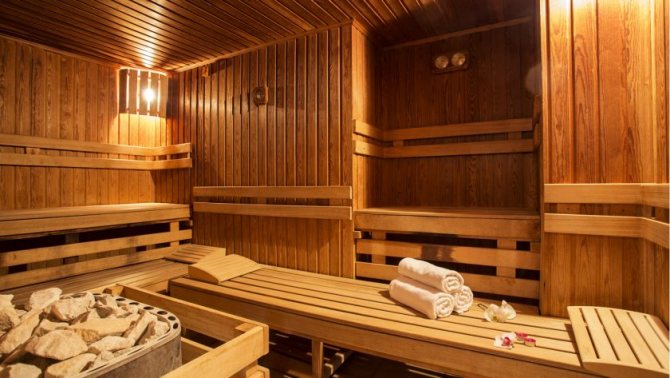

These containers have various shapes: triangular, round, oval, rectangular, square. This is one of the advantages - a variety of forms, there is a choice to your liking.
PROS:
- the heat is not wasted and heats the water
- long service life of the chimney
- there is no "cold steam" effect inherent in built-in and hinged tanks
- saving space in the steam room
MINUSES:
- It is inconvenient to fill the container with water - the filling hole is too high. This minus is smoothed out by the tanks located immediately above the stove.
- Difficult to control water level and temperature
- To have "dry steam", water must not be allowed to boil
- It is difficult to install a container on a chimney, because the weight with liquid reaches 100 kg or more. This requires a good mount - the weight of the tank should not load the stove. But if the tanks come in a set from one manufacturer - there is no minus
There is a convenient and effective way to combine a small chimney tank with a take-out tank. A container with two pipes for hot and cold water is installed on the pipe. It is connected to a larger external tank - this system is used to circulate and heat the liquid.
- It is convenient to mount the tank on the chimney - because it has a small volume and weight, does not require special fastening, as with standard "samovar" tanks
- Since the remote tank can be installed anywhere, it is convenient to fill in water. If there is a water supply system, you can connect to it
- It becomes possible to control the water level
- Since the portable container can be located anywhere: in the dressing room, in the attic - there is no excess moisture in the steam room. There is control over the air condition
- It is possible to take a shower with some effort, but much easier than in the first option
Tank materials
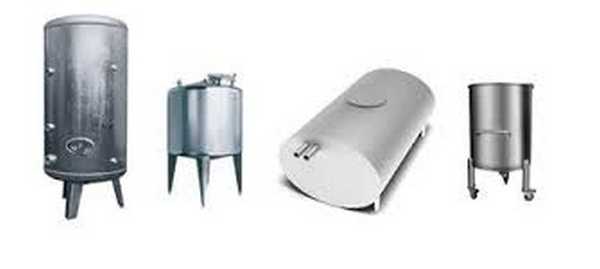

As a rule, tanks are made of stainless steel
Hot water tanks are made of different metals. In the past, cast iron tanks were common. Over time, they were replaced by tanks made of lighter materials - steel and aluminum.
Stainless steel
This metal has replaced heavy cast iron. The liquid in a steel container heats up very quickly. The material tolerates temperature changes well. The tanks do not require protection from high humidity. The only drawback is that water does not retain heat for very long.
Cast iron
In the old days, it was the only material used to make hot water tanks. Cast iron has good durability, resistance to corrosion and temperature changes. The liquid in such a tank remains heated for a very long time. Nowadays, cast-iron tanks are almost not produced due to their large weight, but there is an opportunity to purchase a used container at a more affordable price. A cast-iron tank is mounted under the stove. For large-sized options, it is necessary to prepare the foundation. In addition to weight, the disadvantage is the rather long heating of the water.
Other metals
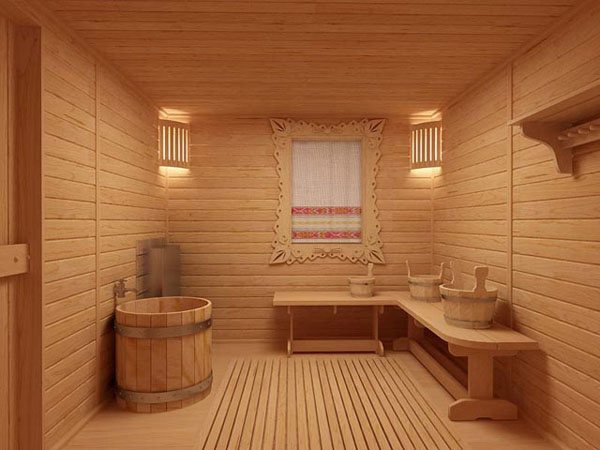

Wooden containers are used for warm or cold water
Enamelled steel is used for the production of hot water tanks. The coating provides protection against corrosion damage to the product. The surface can be easily cleaned of dirt, but it is important not to violate the integrity of the enamel layer, otherwise rust may appear on the container. On sale you can find coated tanks in different colors. Hot water tanks are also made from flexible and lightweight aluminum sheets. This design is easy to do at home. To protect the surface from corrosion, it is recommended to galvanize.
Wood and plastic
The performance characteristics of these materials allow them to be used only for tanks with non-hot water. This is especially true for plastics, which melt when exposed to high temperatures. If there is no running water in the bath and there is a need for a container for warm or cold water, you can use wood or polypropylene products.
Plastic buckets or ladles should not be placed next to the stove, otherwise they may deform.
How to choose the best water tank?
To ensure yourself a pleasant rest, during which you do not have to think about the technical features of the water heating process, we recommend that you pay attention to them even at the design stage of the bath. The choice of a water tank of the optimal volume and configuration is influenced by several factors at once:
- Steam room type.
A classic samovar tank is suitable for a Russian bath, and a Finnish sauna will require the removal of a water tank to a separate room. - The area of the entire bath and steam room.
The built-in small water tank will save the most space. A portable tank is also convenient. - The duration of the visitors' stay in the bath.
Those who like to steam and wash in a couple of hours install samovar tanks in their saunas, while fans of long sessions of vaping (more than 4 hours) are more suitable for portable containers. This is due to their ability to maintain a constant water temperature. - Location of the washing department.
A samovar-type tank is installed in a bathhouse, when the washing room and the steam room are one and the same room. If the guests of the bath do not wash in the steam room, the best solution would be to choose a portable tank. - Features of the room.
The steam room can be so cramped that access to the lid of the samovar tank will be difficult. - The material from which the tank is made.
Many manufacturers offer cast iron and enamel products. The first ones keep warm for a long time, but they also heat up for a long time, and their large weight creates difficulties during transportation and installation. The latter are democratic and simple, but short-lived, and constant contact with water leads to corrosion even on the enamel-protected coating. offers stainless steel water tanks - the most practical and popular material for this application.
Helpful advice: before buying, be sure to calculate how much water tank you need. To do this, take the number of members of your family and multiply this number by 8-10 liters - the hygienic norm for an adult (if you like to steam with a broom, then in addition you will need about 10 liters to steam it).
Experts advise choosing the volume of the water tank with a small margin so that your guests can also enjoy a real hot bath. The optimal capacity parameters are 55-80 liters, although it can also offer miniature boilers for 40 liters for a small family. If the volume of the tank is determined correctly, then you will wait for the water to heat up to 70-75 degrees in 30-50 minutes. At this time, the temperature in the steam room will reach 90 degrees, and you can start to steam.
We offer you to familiarize yourself with Hot water in the country from a well
It is the attention to technical characteristics and scrupulous study of them that guarantee you the choice of a water tank suitable for your bath.
carefully preserves the traditions of the Russian bath, successfully combining them with the latest technological developments. We offer you functional, easy to install and use, high quality and efficient sauna stoves with a water tank. Contact our managers for advice and get comprehensive information about the products.
Requirements for a water heater in a bath
Manufacturers make sauna stoves with ready-made water tanks. This option is the easiest for installation and further operation. It is relevant for buildings to which gas and water supply communications are not connected, a limit for the use of electricity has been determined.
Hot water tanks can be installed in two ways:
- The tank is placed directly on the chimney of the furnace, the liquid is heated by the heat of the smoke coming out. At the same time, the pipe can heat up to very high temperatures (500⁰C), quickly warming up the contents of the tank. The bottom of the tank is equipped with an opening equal to the section of the chimney. It is necessary to ensure the tightness of the joints of the pipe and the reservoir at the inlet so that water does not flow out. The joint can be treated with a heat-resistant sealant, clay-lime-sand mortar. The cement mortar cracks when exposed to heat. At the same time, such an arrangement allows you to heat the water with heat, which is usually discharged outside. And it is easier to mount the chimney inside the attic space, since excess heat is given off to the water.
- Hinged tank.It is placed in a wall-mounted way on one side of the stove, most often inside a steam room (capacity 40-70 l). A wood-burning stove heats up the water in the tank in 1.2-1.6 hours. To speed up the process, you can insulate the tank. Also, a simple, budgetary method that does not require significant material costs, easy to maintain.
Placing such a tank inside the steam room is considered a disadvantage due to the large release of water vapor. For bath buildings located in the country, this is one of the few available ways of heating water that does not require efforts for winter arrangement. An up-to-date option for a classic Russian bath. It is not recommended to equip the sauna with such a reservoir.
- Separate placement from the oven;
- Can be used for a sauna;
- Ease of operation;
- Minimal resource consumption.
The complicated design is a disadvantage, which is compensated by the convenience of placement and functionality.
Criteria for maintaining the health of the bathhouse attendant
- It is necessary that the stones are heated over 200 degrees so that the water turns into good and useful steam.
- At the floor, the temperature should be about 40-45 degrees, and under the ceiling 90-100.
- A good system is needed to remove smoke, carbon monoxide and other dirty elements. In addition, it must correspond to the timely combustion of fuel and uniform heating of the steam room. So that there is no excess infrared radiation in the steam room.
- the base must be solid - made of concrete or brick
- the oven must be positioned so that the walls of the device are at least 50 cm away from flammable materials
- the area adjacent to the furnace must be made of refractory materials
Furnace models
Only you can decide which model is best for your bath. Before deciding on a choice, you need to study the most popular oven models on the market.
"Ermak" - this device is made of metal. A register, a pre-flow tunnel, a hinged tank are installed in it. The most popular type of "Ermak" can heat a bath with an area of 12 m3. Its price is 8500-13500 rubles.
"Teplodar" is a model of stoves with a remote tank. Its price ranges from 7,000 to 30,000 rubles. The cost is influenced by factors such as design and certain functions: self-cooling door, high efficiency of the heater with low chimney load.
"Breneran" - designed for dry baths, like a Finnish sauna. They are known for their excellent quality, ease of use, and low price for such quality. The stove is of open and closed type, cast iron grates. Price from 10,000 to 50,000 rubles.
"Kolibri 9B" - is made for use in personal steam rooms. The set includes a built-in hinged register. The construction is made of stainless steel.
The main advantages are the combination of receiving hot water and steam at the same time, control of water consumption. This saves fluid.

